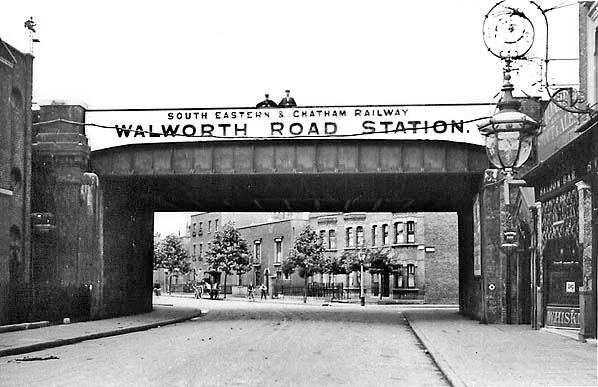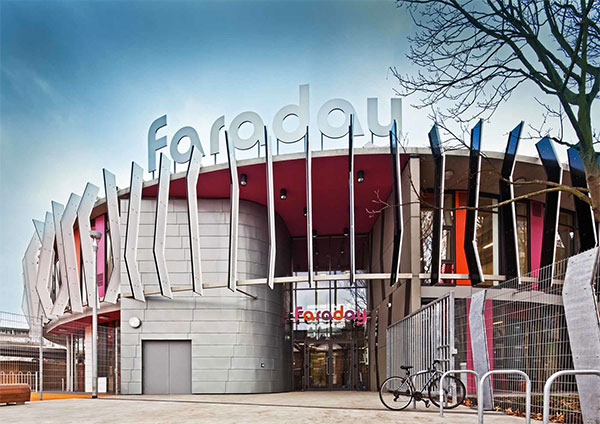A Timeline History of Walworth


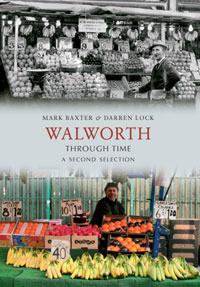
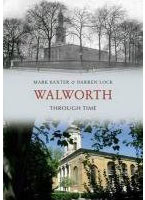
• Click on images to enlarge
Famous Residents
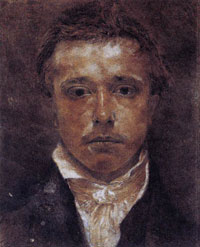
Samuel Palmer

Walworth Food Shops
Walworth Restaurants
Walworth Shops
|
|---|
Prehistoric Walworth
Remains of a mammoth found under Hillingdon Estate
Roman Walworth
C1 Watling Street Roman road built (Old Kent Road is built on it)
Saxon Walworth
C5 Saxons called the area Wealawyrd or Waleorde meaning 'farm of the Britons'
c1015 King Edmund Ironside granted Hitard, a court jester, land in Walworth.
1052 Hitard went on a pilgrimage to Rome. Made over his land to Church of Christ in Canterbury, Canterbury Cathedral.
Medieval Walworth
1086 Walworth was described in Domesday Book. Mentioned land for ploughing and growing corn and eight acres of meadowland for cows. Walworth now a village in Surrey seperated from Camberwell by a stream
which ran by Boundary Lane on Walworth Common (where Aylesbury Estate is situated now).
C15? Pilgrims to shrine of Becket at Canterbury Cathedral
stopped to water horses at stream on Old Kent Road on Walworth Common. Place was known as St Thomas a Watering (now Thomas a Becket pub).
Tudor Walworth
Manor House built?
Stuart Walworth
1681 Map of Walworth made for Dean and Chapter of Canterbury
Cathedral.
Map showed St Mary Newington church, a maypole on Newington Causeway and
a common called Lattam-more (Lower Moor) now Lorrimore Square.
Georgian Walworth
1734 Walworth workhouse established west of Walworth Road (closed 1850)

1748 Rocque's map of London showed a windmill west
of Newington Causeway.and a windmill on Bethwin Road.
C18 Manor House (where Manor Place is) demolished.
1770s Montpelier Tavern opened the Montpelier Tea Garden in Walworth.
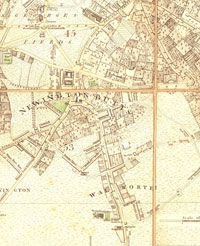
1790 The York Street Independent Chapel opened on south side of York Street (now Browning Street).
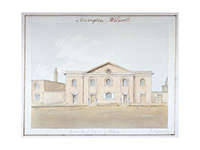
1795 Surrey Square built by Michael Searles.
1796 Cricket match played at The Montpelier in Walworth.
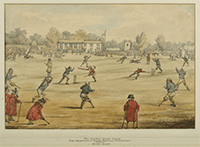
1801 Population 14,800
1805 Samuel Palmer, the artist, born in Surrey Square.
1808 David Hughson described Walworth Road as "lined by elegant mansions”.
Regency Walworth
1825 St Peters Church built for Church Commissioners as a result of Walworth’s expanding population. Architect: by Sir John Soane (1753-1837). More info
Early Victorian Walworth
1831 Surrey Zoological Gardens opened by Edward Cross (1774-1854) on Lorrimore common (old Walworth Manor)
Map by Victor Keegan
1842 A Congregational chapel, the Sutherland Chapel, was built between St. Peter's Church and the Walworth Road. In 1904 the building was closed and was later taken over by the Electric Theatre Company.
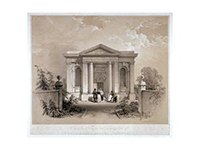
1848 Queen Victoria & family visited Zoo. Then named
Royal Surrey Zoological Gardens.
1850 Newington workhouse built at 182 Westmoreland Road (now Beaconsfield Road) (Newington Lodge in 1930)
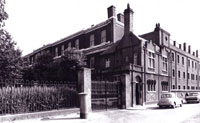
1852 St Peters School.
1856 Surrey Zoological Gardens replaced by Surrey Gardens
Music Hall.
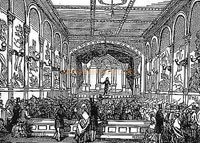
1856 St Paul Church built on Lorrimore Square
1857 Surrey Gardens closed down.
1858 Surrey Music Hall opened in old Zoological Gardens.
Mid Victorian Walworth
1860 St John built in Larcom Street.
1862 Map
1861 Metropolitan Tabernacle built at Elephant & Castle.
1862 Canterbury Cathedral gave their land in Walworth to
Church Commissioners.
Railway built through Walworth.
1863 Walworth Road Station opened on London, Chatham and Dover Railway Line.
1865 Vestry of St Mary Newington opened on Walworth Road.
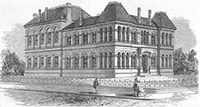
1866 St John's School.
1866 St John's School opened on Larcom Street.
1869–77 Edward Yates (1838–1907), a local builder, developed the Georgian residential streets on the western side of the Old Kent Road. Also built on the eastern side, laying out Marcia Road. Yates was leased and built on land owned by the Rolls estate and the Ecclesiastical Commissioners in Walworth. Walworth moved from a Georgian suburb to Victorian inner city, with long rows of terraces built speculatively for rental, to house lower middle class and working class residents. By the time of his death, an estate of just over 2,500 houses, a church and school had been built, to match the rise in the population of Walworth.
(Today, the streets constructed by Edward Yates form part of the Larcom Street Conservation Area).
1871 Tram lines laid in Old Kent Road and Walworth Road
for horse drawn trams.
1872 Surrey Gardens Music Hall demolished. Penton Place
covers part of the site.
Late Victorian Walworth
1889 Charie Chaplin born above a shop in East Street.
1891 Sanford Road School (now Walworth Lower School).
1892 Pembroke College Mission set up by Pembroke College, Cambridge.
Carter Street Police station opened.
Huntsman & Hounds public house built off East Street.
Newington Library opened at 155-157 Walworth Road next to the Vestry. Designed by Edward I'Anson (1812-1888) & constructed out of parish rates by a special vestry committee.

1895 York Chapel renamed Browning Hall after Robert Browning who was baptised there in 1812.
The Browning Settlement set up by FH Stead (1857-1928) started at Browning Hall. It was inaugarated with a speech by Herbert Asquith.
Drawing (1953) of Browning Hall
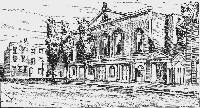
Public space created for public from St Peters graveyard.
1898 Browning Hall conference on Pensions led to the Old Age Pensions Act of 1908
Edwardian Walworth
1900 Vestry became Southwark Town Hall
1901 Population 122,200
1902 Henry Coming (1817-1902) left funds in his will to create a public museum to house his family’s collection.
Browning Settlement moved to 62 Camberwell Road.
1903 Traders moved off Old Kent Road and Walworth Road by authorities to East Street due to new electric trams.
1904 Electric trams introduced in Walworth.
1905 22 acres of slums cleared around Merrow Street by Church Commissioners.
1906-1907 600 modern flats and houses built by Church Commissioners to replace slums. Managed by Octavia Hill (1838-1912) who encouraged Church Commissioners to add an open space, Faraday Gardens.
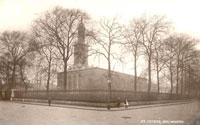
1906 The Cuming Museum first opened in galleries above the Newington Library on Walworth Road
1908 Electric Theatre opened at 341 Walworth Road
1910 Elephant & Castle Cinematograph Theatre opened (800 seats) at 47-51 Walworth Road
c1910 Photograph of East Street Market showing the Royal Albert (No 51)
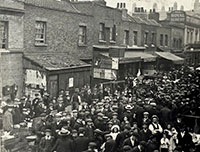
1913 Purple Picture Hall opened on Arnside Street, SE17 2EY. Owned by Abraham Simons.

WW1 & Walworth
1916 Walworth Road Station closed.
Pre-War Walworth
1930 Walworth Road (north) towards old Elephant pub
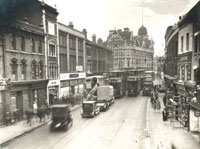
1933 Family of Michael Caine (born Maurice Micklewhite) moved to a two-room top floor flat (with outside toilet) at 14 Urlwin Street, SE5. Later attended John Ruskin School.
1939 Reverend James Butterworth (1897-1977) advocated ‘a house for friendship for boys and girls outside any church’. He replaced the Walworth Methodist Chapel on Camberwell Road with a new chapel & Clubland. Designed by Sir Edward Maufe (1882-1974), the architect of Guildford Cathedral. Clubland featured a theatre, gymnasium, tennis court & various club rooms. Opened by Queen Mary on 18th May. Robert Kennedy (1925-1968) made his first public speech at Clubland at the age of 13, when his father was the US Ambassador.
WW2 & Walworth
1940 Walworth bombed in Blitz.
St Peters hit by bombs - seventy people killed in the crypt
Post War Walworth
1952 Trams discontinued.
1958 Brandon Estate built.
1960 Film of Walworth Road
New St Paul’s Church opened on Lorrimore Square. Modernist Grade II-listed building of reinforced concrete designed by Woodroffe Buchanan & Coulter
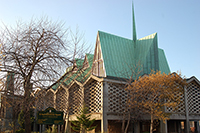
1963 Work started on the Aylesbury Estate
1964 South of River Film (35:23 East Street)
1965 Southwark Town Hall moved from Walworth Road to Peckham Road after borough of Camberwell merged with Southwark.
1971 Film of East Street Market
1974 Heygate Estate completed.
1977 Aylesbury Estate completed. Extended from East Street to Albany Street.
1978 Browning Hall (old York Chapel) demolished on Browning Street after fire damage.
An open area with the tomb of Captain James Wilson (1780-1814) remains.
2010 New Faraday School opened on Portland Street. Designed by Will Alsop (1947-2018).
2013 Cuming Museum and Library damaged by a fire (film).
2014 Heygate Estate demolished (info and photos).
2020 Work begun on demolition of Aylesbury estate.
2021 Southwark Heritage Centre and Walworth Library opened at 145 Walworth Road (near old Town Hall). It incorporates items from the Cuming Museum.
2023 Una Marson library opened on Thurlow Street. Named after the writer Una Marson (1905-1965) described by her biographer as the first "Black British feminist to speak out against racism and sexism in Britain"
Booklist
The Story of Walworth - Mary Boast (Southwark Council 1976)
The Walworth Guide
More South London History Timelines




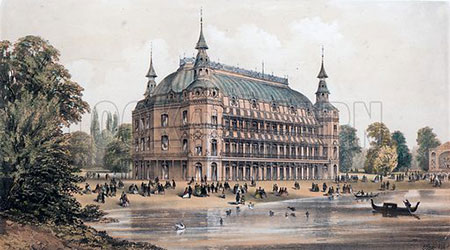 Surrey Gardens Concert Hall (C19).
Surrey Gardens Concert Hall (C19).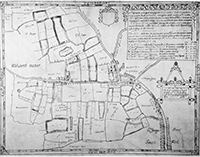
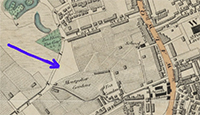
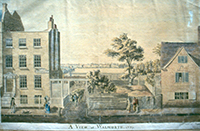

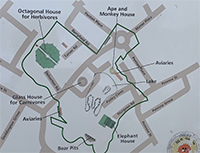
_10_154_1_Die_Giraffen_und_Antilopen_mit_ihren_nubischen_Wärtern_in_London2.jpg)
